| Photojournal
- 30
July 2006
Lady
pupae
|
Sunday the 30th got
off to a slow start for me, and after brunch and some errands
I found myself coming home around 4pm. I had my camera with me;
I had thought that I was going to go out shooting after brunch,
but ended up not doing that.
As I was climbing the
stairs to my condo, I noticed a fly on the handrail to the stairs,
where I've often seen these sorts of flies. (This is a little
odd, because I don't see them elsewhere around the property with
any regularity.)
Anyhow, I put down
my shopping and turned on my camera and flash, moving in as close
to the fly as I could. I took a few shots, and the fly didn't
budge.
|
|
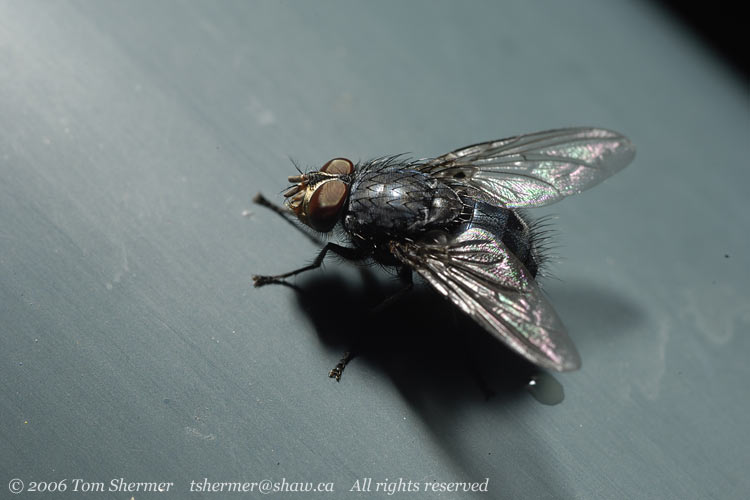 |
| Once inside,
I downloaded the photo and was blown away. The detail in the shot
was just amazing. Here's the face of that fly, from the same photo. |
|
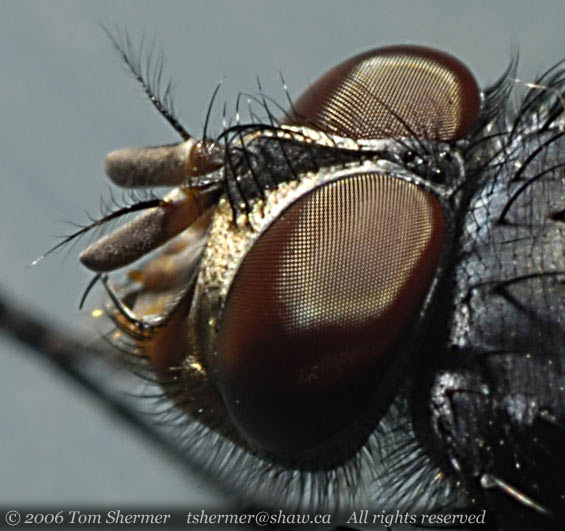 |
|
That was perhaps the
best macro shot that I'd ever taken, and it was just a casual
hand-held shot. I hadn't even been trying super-hard or anything.
It was very unexpected.
Anyhow, seeing what
I had just shot got me all fired up and excited, and it motivated
me to go back out and take more photos. I headed back out with
my macro rig, including tripod and rail. My first stop was at
the Gladiolas that I had taken photos of the day before. Honeybees
were still coming by to pay their respects, and here I caught
another one buzzing around in front of the flower.
|
|
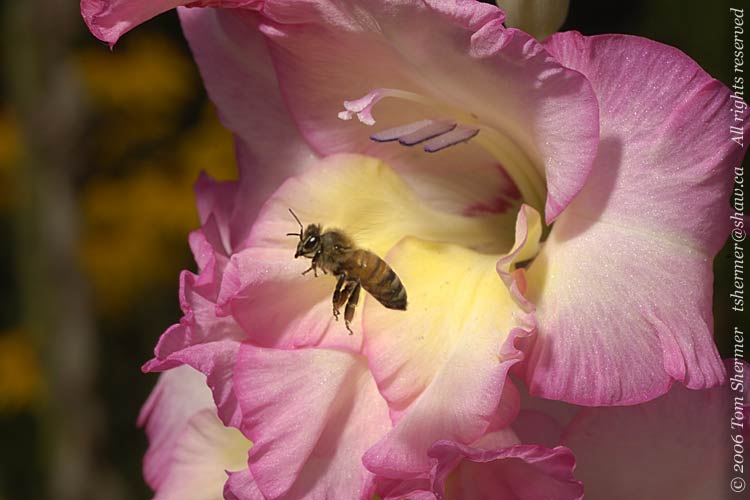 |
| Nearby
I found this Anthidium bee crawling around on some fading
reddish flowers. It looked like some practical joker had sprinkled
a bit of pollen on his head, and the poor bee didn't have the sense
to shake it off. |
|
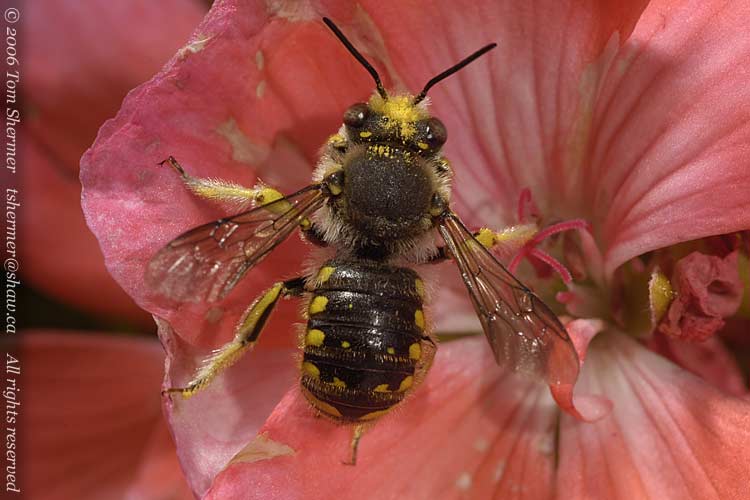 |
| Next I headed
down the promenade at the quay. Past the little park with the submarine,
the flowerbeds started. On some stringy purple flowers there, I
found this little butterfly. Later I hit the books and then asked
around, and found out that he's a Woodland Skipper, a fairly common
little guy this time of year. |
|
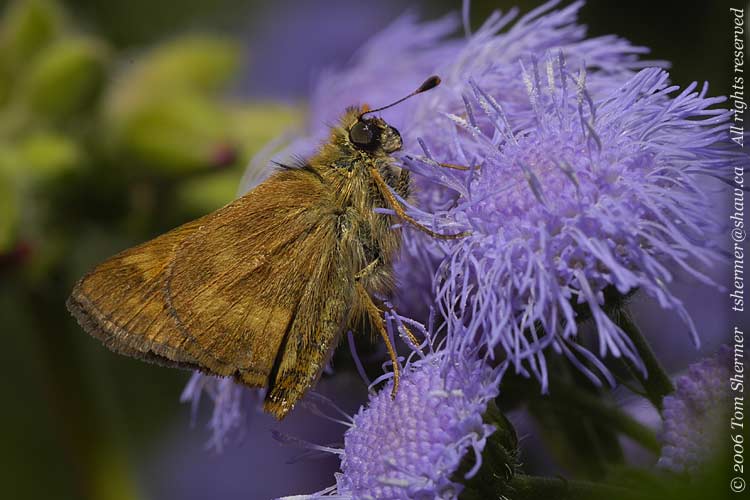 |
|
Next, I came across
some really pretty, intricate flowers. My friend Karla identified
them as Passion Flowers for me. The particular kind is either
Passiflora 'Amethyst' or Passiflora 'Lavender Lady',
two similar-looking cultivars that seem to get very confused.
P. 'Amethyst' was a hybrid created a long time ago in the
UK, and P. 'Lavender Lady' was created in 1982 in the states.
It was poorly named, because 'Lavender Lady' was already sometimes
used as a synonym for 'Amethyst', so now when people call something
'Lavender Lady' you don't know which cultivar they're talking
about. To top it off, they look pretty similar, and they also
look a bit like Passiflora Amethystina, which is a real
species, not a cultivated variety.
Anyhow, regardless
of their exact identity, they are very cool flowers, showing interesting
3-fold, 5-fold, and many-fold symmetry. Here's two shots of one
of them, the first with a small depth-of-field, and the second
with larger depth-of-field.
|
|
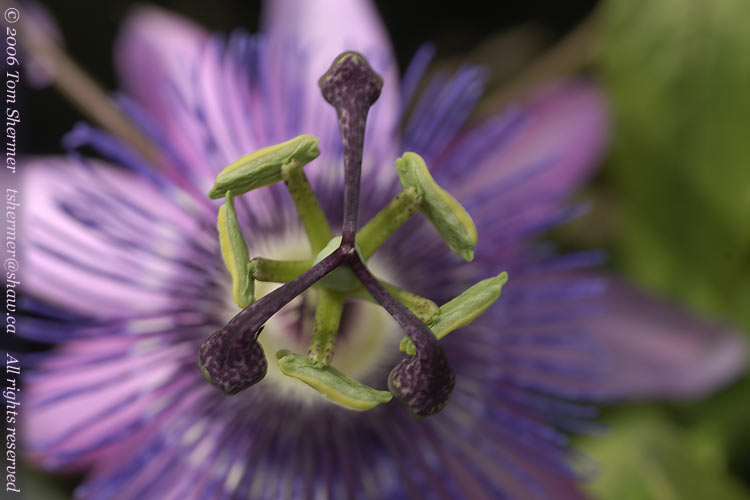 |
| |
|
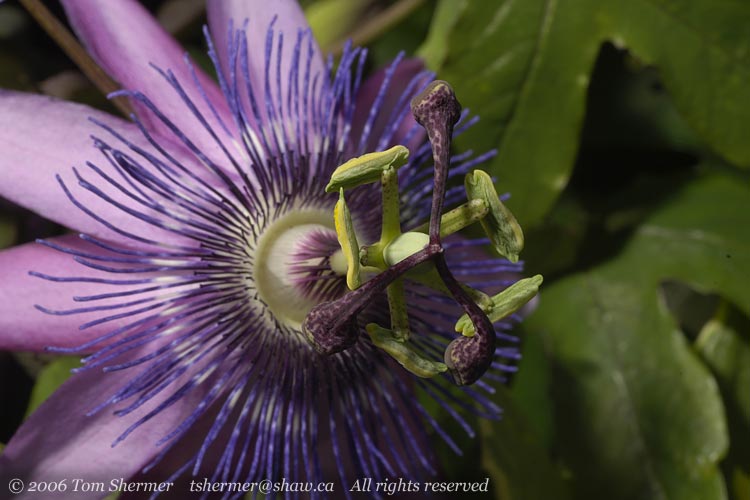 |
| I wandered
down the entire length of the promenade, but not quite all the way
to the market. Towards the end, there was a bed of succulents, which
I stood above to take this shot. I was standing tippy-toe to try
to get the entire plant in the frame, but wasn't quite tall enough.
It still turned out pretty well. |
|
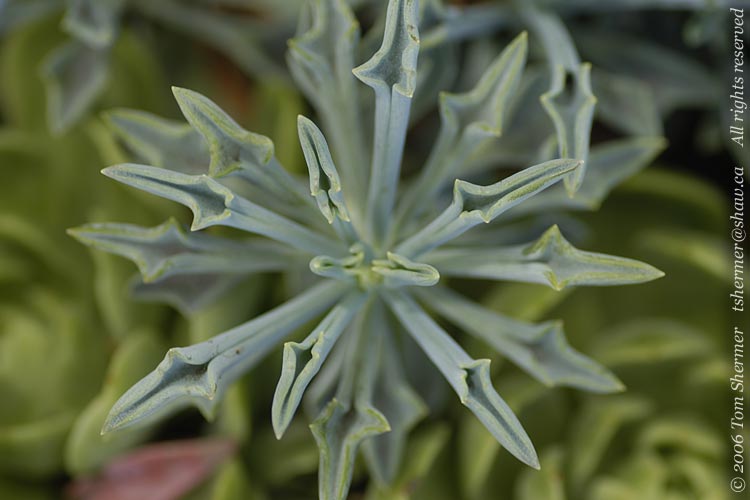 |
| On the way
back, I stopped when I saw a long, conical orange fly. This is a
snipe fly known as Rhagio tringarius, an invasive species
originally from Europe. |
|
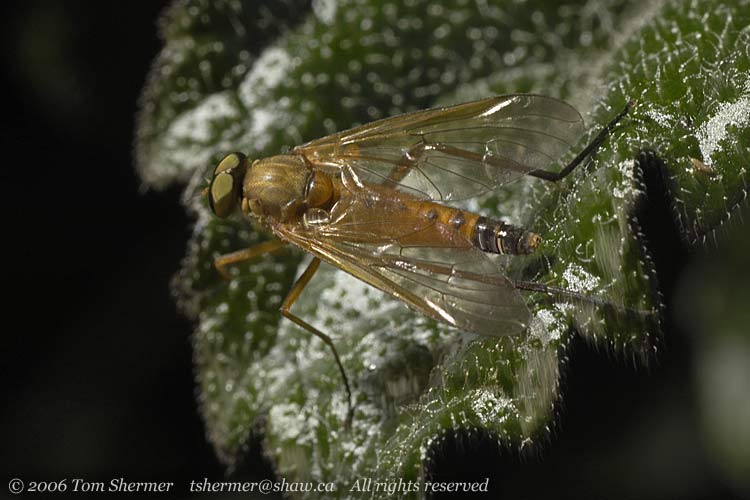 |
|
After Ms. tringarius
flew off, I continued along until I spotted a little orange ball
on the side of a leaf. The orange, black, and shape looked conspicuously
like the ladybug larva I'd seen a few days before, so when I saw
the little spiny things holding it to the leaf I knew I'd found
a pupa of the Harmonia axyridis ladybug.
|
|
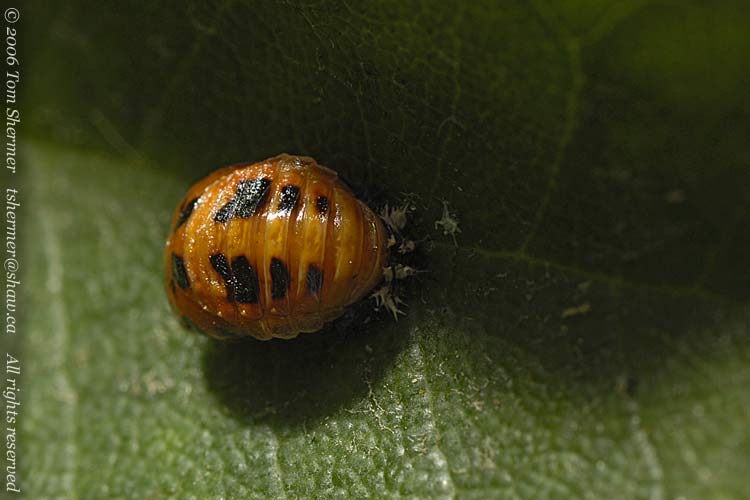 |
| Here's a
side view of the same pupa, showing the spiky spiny bits. Overall,
it's a very pretty little thing. |
|
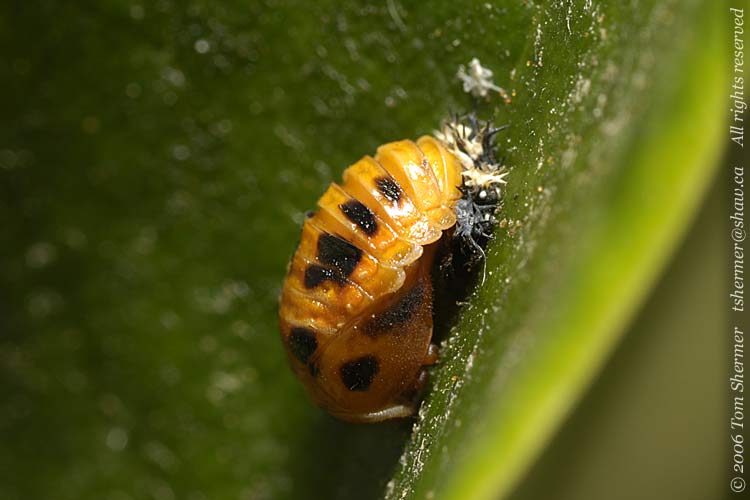 |
|
I don't know how long
ladybugs pupate, but once they're done, they emerge as the fully-formed
little beetles that we're all pretty familiar with. What I wasn't
that familiar with is just what a ladybug's face really looks
like; it's often hidden under their thorax.
Well, for the second
time in two days, I found myself staring a ladybug right in the
face. An adult ladybug was on the same plant, headed towards me,
and I was able to position my camera and flash so as to get a
pretty skookum face shot. The photo shows her interesting (and
pretty scary) antennae and mouthparts. This is a view to strike
fear into the heart of any aphid.
|
|
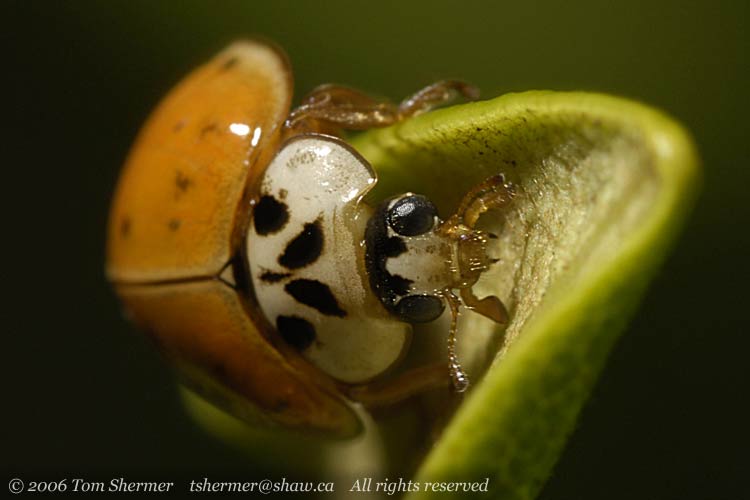 |
|
Speaking of which,
a little later I found a plant with big, broad leaves. Turning
one of the leaves upside-down, I found a large congregation of
aphids. These guys were a bit bigger than the ones I had photographed
a few days back near my place; there were some adults (the ones
with wings) and some really bloated little ones.
I couldn't get a very
good shot of them, as I had to twist the leaf sideways with one
hand, while dealing with the camera and flash with the other.
|
|
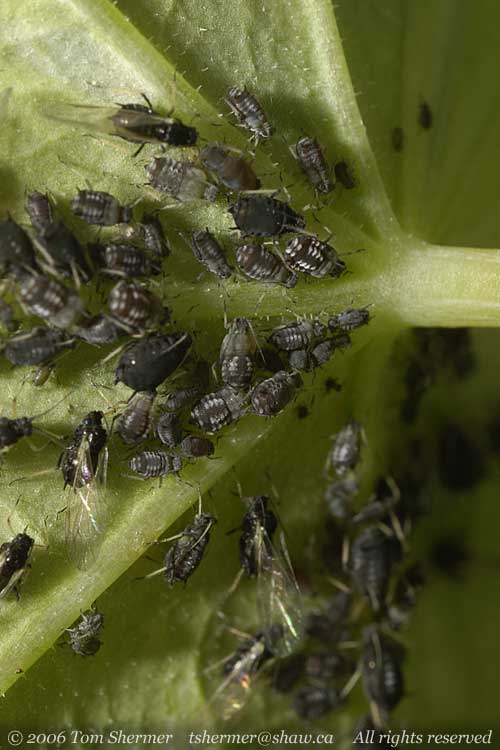 |
| My last
subjects of the day were some more ladybug pupae—or at least
ladybug pupal cases. I'm not sure if this one is empty, but it had
changed color from orange to whitish brown. |
|
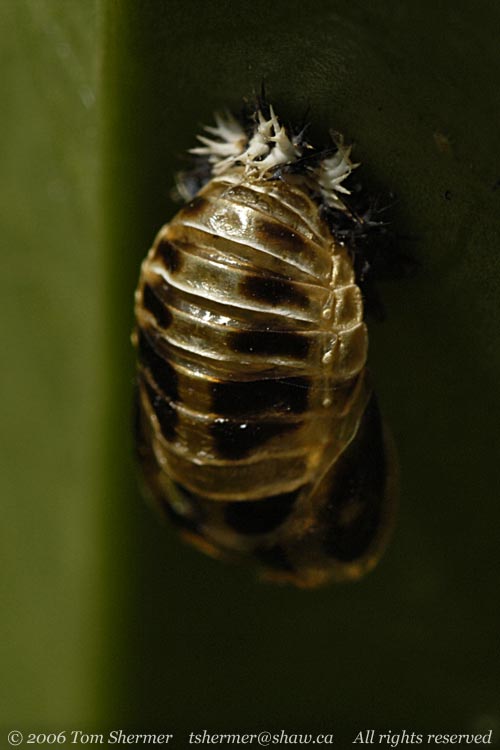 |
| But this
one is definitely empy; a lady has left this case behind. |
|
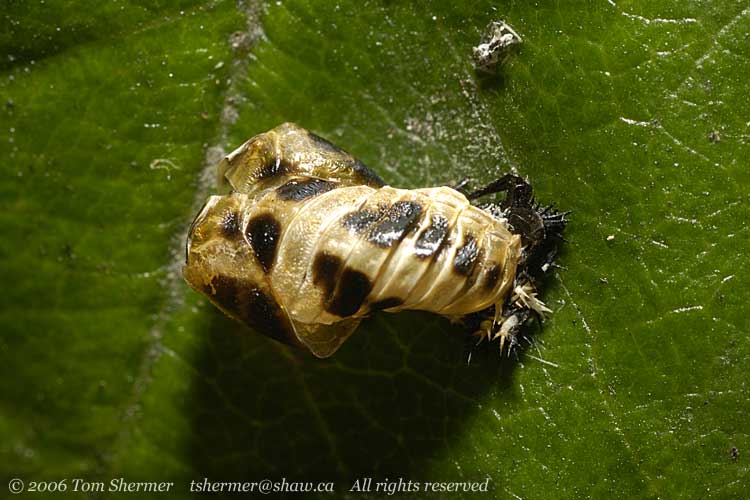 |
|
It had been a pleasant
walk down the quay, and finding the ladybug pupae and casings
was satisfying, as it nicely complemented my photos of adult and
larval ladybugs. Now I'm going to have to be on the lookout for
ladybug eggs, once I learn what to look for.
Having the full macro
gear along helped, too...many of these photos wouldn't have turned
out so nice without it.
Currently neither a
larva nor a pupa,
Tom
|
|
|